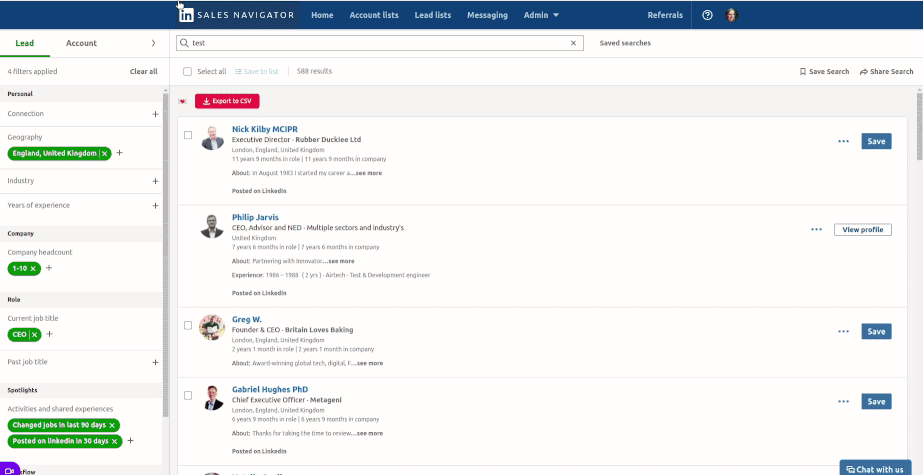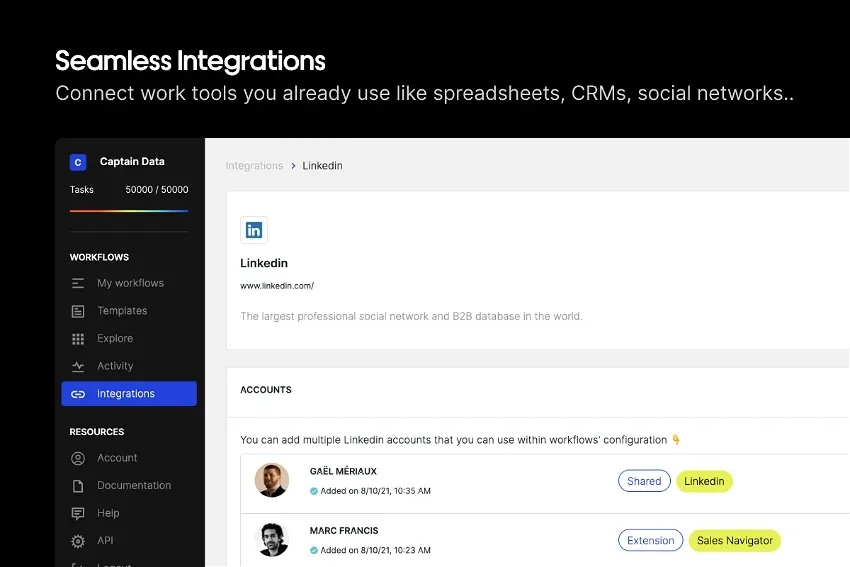Sustainable sales growth isn't a byproduct of throwing darts at the sales walls and hoping something will stick. If you want to create strategic campaigns, you need strategic lead enrichment.
Collecting data on your leads and customers isn't enough. You need to know what data to collect, how to keep it clean and most importantly, how to use it properly if you want to generate results.
In this article, we’re taking a look at strategic lead enrichment. Or, as I like to think of it, gathering data with direction. We'll cover:
- What it means to enrich your data
- How lead enrichment helps sales
- Key categories of lead enrichment data
- Ways to use your newly-enriched lead data
- How to develop and implement your lead enrichment strategy
- The best tools for lead enrichment
What Is Lead Enrichment?
At its core, lead enrichment gives you more information about the audience members you’re hoping to transform into customers. It's about adding as many relevant data points as possible to your record so that, when it comes time to communicate with your lead, you have the information you need to make your outreach effective.
Imagine a sales rep, Sarah, who is in B2B software sales. She finds a lead, John Smith. Initially, all she has is John's name and email address.
Using lead enrichment tools, Sarah discovers that John's job title is "Chief Technology Officer" at a medium-sized tech company. This enriched data helps Sarah tailor her approach when reaching out to John. Instead of starting with a generic pitch, Sarah can now craft a message that speaks directly to John's role and challenges as a CTO.

Her boss, a sales manager we’ll call Michaela, can analyze the effectiveness of different sales strategies based on job titles. She might notice that sales reps have a higher success rate when reaching out to CTOs compared to other job titles. Knowing this, Michaela can adjust the team's targeting to focus more on prospects with similar job titles.
Now, let's consider their sales director, Emily. Thanks to enriched data in their CRM, Emily can analyze which industries are most receptive to their product.
For example, she might discover that companies in the technology sector with CTOs as decision-makers tend to convert at a higher rate. Based on this insight, she can prioritize certain market segments to increase overall sales.
How Can Lead Enrichment Help Sales?
In addition to the goals above, there are other tangible benefits of lead enrichment, including the following:
- Streamlined Sales Processes: There’s no need for sales reps to manually collect data. The tools take care of it, so they only have to think about the tactics and results.
- Accelerated Lead Engagement: With comprehensive profiles, it’s easier to know what to say (and do) to engage every lead.
- Smarter Sales Strategies: Instead of hoping for the best, you know exactly who your leads are and how your messaging can be(come) more relevant.
- Personalization at Scale: Once the lead enrichment data is in your CRM, you can automate your workflows as you normally would, personalizing for each lead type.
- Cleaner Data: When implemented correctly, lead enrichment tools automatically cleanse and verify the existing data, so your team is confident in its accuracy.
Ultimately, lead enrichment helps at all levels – from the day-to-day outreach to the entire company’s approach to revenue leadership.
The 7 Key Types of Data for Lead Enrichment
The effectiveness of your lead enrichment strategy hinges on collecting the right type of data for your goals.
For example, if your goal is boosting outbound activity, you would start with market triggers. Conversely, if you want to revitalize stale CRM data, you could focus on lead enrichment that updates missing fields and re-verifies data.
Accuracy is non-negotiable. Bad data is a recipe for operational headaches and missed opportunities, which means less revenue.
Consider the case of bad contact data. Invalid or outdated email addresses not only decrease the likelihood that you'll connect with your target audience, they dramatically increase the likelihood that you'll end up on the wrong side of a blacklist.
Most sales teams focus on these seven data categories when developing an enrichment strategy. It's not an exhaustive list, however, and an effective strategy won't necessarily cover all of these types.
Remember, we want to think intentionally and strategically about the data you need to meet a specific sales goal.
Contact Information
Accurate contact data is the foundation of any personalized marketing or sales strategy. Without this information – names, email addresses, phone numbers – you literally can't communicate with potential customers because you can't reach them.
There are a number of ways to source this information, but the most efficient are tools designed to scan websites, social media platforms and other sources and extract relevant contact data. For example, Findymail uses a custom algorithm to find and verify email addresses for leads in your Sales Navigator or Apollo lead lists.
But beware of data decay. If you built your lead list a few months ago, many of the addresses may no longer be valid. That means a higher chance of either a hard bounce or the SPAM folder. And with every email that bounces or doesn’t reach the sender, you’re not just wasting your efforts – you also damage your sender reputation.
The fix? Develop a plan to regularly cleanse your CRM data to identify gaps in your records, remove outdated information, and merge dupliate records. Depending on teh size of your CRM and the tool you use, you can set aside time to do this manually. In our experience, however, automation saves you time and removes the risk of human error.

Intent Data
Possibly one of the most powerful types of enrichment data, intent data reveals a lead’s potential interest in purchasing products or services based on their online research activities and behaviors.
It includes signals such as the following:
- Search queries
- Content consumption
- Site visits related to specific topics
With intent data, you can predict purchase intent and intercept the lead when they’re most likely to hear your proposal. You can also leverage it for lead scoring, so you prioritize leads actively researching solutions in your category.
Firmographics
For B2B companies, firmographic data is akin to demographic data for individuals. It includes company-related details such as industry, size (number of employees), revenue and geographic location.
With firmographic lead enrichment data, you can target and segment audiences at an organizational level.
For example, you might spot that segments that are in the 500-1k employee size prefer your product’s integration feature, while small business customers prefer assisted setup. This allows you to emphasize each segment’s favorite aspect first.
Technographics
If you’re in B2B sales, technographic data offers insights into the software solutions a prospect currently uses.
You can identify compatibility between your products and the prospect's existing tech stack. It can also highlight opportunities for integration, improvement or replacement of current solutions, so your pitch addresses specific gaps or frustrations.
Behavioral Data
Buyer journeys are never linear, but behavioral data is as close as you can come to knowing what the lead is currently thinking.
Behavioral data tracks a lead's actions, such as website visits, content downloads and engagement with marketing emails. It provides a window into the interests and readiness to engage.
For example, if you notice they’re in the awareness stage, you can start sales conversations by nurturing them with educational collateral. If they’re actively comparing solutions, you can send them information with contextual advice in their use case.
Ultimately, behavioral data allows you to spot patterns, identify high-intent leads, tailor follow-up strategies and deliver content that moves leads further down the sales funnel.
Geographic Data
Knowing where your leads are located allows for the creation of region-specific offers and content. Geographic data can inform local marketing strategies, compliance with regional regulations and even logistical considerations for product delivery.
Again, lead enrichment data is all about your goals: How will you use this data? Knowing the goal, reverse-engineer to find the exact data points you’d need.
Demographics
While demographic data is typical for B2C (it includes gender and income), it can be a great entry point in B2B.
Once you understand the demographic profile of your stakeholders, you can tailor your content to meet their specific goals and challenges on a personal, human-to-human level.
How to Use Lead Enrichment Data
Still stumped on which data types to incorporate in your lead enrichment strategy? Think about how you'd like to communicate with your prospects to get a better understanding of what data you need to reach your sales goals.
Let's say you want to double your cold outreach efforts by the end of the quarter. Ask yourself, "What data do I absolutely need to make this possible?" At minimum, you're going to need valid email addresses for your new lists. Other non-negotiables might include basic firmographic data or intent data.
Would it be nice to have some information about where your targets live or whether they prefer dogs or cats? Sure. But unless you're running gourmet cat and dog food company that delivers only to residents of Los Angeles, you don't actually need it to send effective campaigns.
The below are some of the most common ways to leverage enriched leads for more targeted outreach.
Personalized Campaigns
The depth of personalization possible with enriched data can’t be overstated. By understanding not just who your leads are but what they care about, you can craft messages that speak directly to their needs, desires and pain points.
For example, if you deal with buying committees, you can pinpoint every stakeholder’s needs. The sales rep cares about ease of use. The sales manager cares about performance improvement. The sales ops manager cares about integrations. Your messaging would address all three.
This could mean segmenting your audience based on interests and using argumentation that connects on a personal level, leading to higher engagement rates and a stronger emotional connection with your brand.
Timely Outreach
Intent data reveals when leads are most likely to be receptive to your offers.
By tracking online behaviors, you can pinpoint the exact moment a lead is researching solutions. This precision in timing ensures your message is not just seen but is also relevant, greatly increasing the conversion chances.
Improved Lead Scoring
Traditional lead scoring often relies on basic demographic and firmographic data.
However, enriched data brings a new dimension to scoring by incorporating behavioral and engagement metrics.
This allows for a more nuanced assessment of lead readiness, prioritizing leads that are both a good ICP fit and also closer to making a purchase decision, allowing you to improve your sales velocity.
New Upselling Opportunities
Understanding the hierarchy and roles within a prospect's organization opens up new avenues for upselling.
Enriched data provides a map of decision-makers and influencers, so you adapt your strategy based on each decision-maker’s specific needs. This strategic approach can uncover new opportunities for upselling and cross-selling, expanding your footprint within key accounts.
Creating a Lead Enrichment Blueprint
If you want to customize your lead enrichment to fit like a glove, identify and prioritize data that aligns with your objectives. But don’t go about it without a plan.
Phase 1: Data Collection
First, identify the types of data that will most effectively support your goals. This means going beyond basic contact information to gather comprehensive insights into leads' behaviors, preferences and needs.
For example, if you want to improve your sales velocity, you would incorporate intent data to meet prospects when they’re the closest to making a purchase.
Phase 2: Lead Enrichment
Once you understand the most appealing value propositions for each ICP type, build campaigns that address them. Since the data is integrated with your CRM, it won’t be a manual effort.
Most CRMs will allow you to personalize campaigns at scale by dynamically adjusting the content based on the data values.

Phase 3: Lead Assignment
With enriched data, you can more strategically assign leads to sales or marketing team members who are best equipped to engage them.
For example, leads with a high engagement in tech-related content would be best served by a salesperson with a strong understanding of tech solutions.
Phase 4: Nurturing the Leads
The journey doesn't end with conversion. Enriched data supports ongoing engagement, allowing you to warm up leads or increase the customer’s lifetime value.

Implementing Lead Enrichment in Your CRM
Now that you've narrowed down the "who" and the "what" or your lead enrichment strategy, it's time to tackle the "how." As in, "How are you going to implement this new plan of yours?"
Actual implementation is where we often see companies give up. Faced with a messy CRM, overworked sales managers pull the plug because they think rolling out a new strategy for data cleansing and enrichment will cost more in lost time than its worth in new leads.
It doesn't have to be that way, though! The steps below break down the process into bite-sized chunks. You can use them as a basic roadmap and build on them to meet your team's specific needs, or treat them like a checklist.
Step 1. Choose a Lead Enrichment Tool
Select lead enrichment tools or services that integrate well with your CRM system.
Look for tools that offer the data types you need, such as job titles, company size, industry, etc. and have a reputation for accuracy and reliability.
Step 2. Define Enrichment Criteria
Determine which data points are most valuable for your teams.
Consider factors like job title, company size, industry, location, revenue and any other data you need to achieve your goals.
Step 3. Automate the Lead Enrichment Process
Set up automation rules or integrations within your CRM system to trigger lead enrichment when new leads are added or existing leads are updated. For example, Findymail's CRM Datacare will automatically review any new lead added to your CRM and update the relevant fields, eliminating the need for a manual search and update process.
The goal is to always have accurate data that’s refreshed and cleaned without your manual intervention.
Step 4. Enrich Leads in Bulk and Integrate Data into Lead Records
If you have a large database of leads, consider enriching them in bulk to ensure consistency and completeness of data. Look for batch processing capabilities in the tools you are considering.
Once lead enrichment is complete, ensure the enriched data is integrated into your CRM and associated with the corresponding lead records.
Step 5. Monitor Data Quality
Regularly monitor the quality and accuracy to ensure it stays reliable as more leads and data flow in. If you spot discrepancies or issues, address them as soon as possible.
In most cases, it’s best to schedule quarterly or bi-annual data cleansing checkups. Alternatively, you can automate the entire process with a tool like CRM Datacare.
Step 6. Measure the Impact of Lead Enrichment
Finally, track key performance metrics, such as lead conversion rates, pipeline velocity and sales revenue, to see how lead enrichment has affected your overall efforts. Then, refine as needed.
The Best Tools for Lead Enrichment
When it comes to lead enrichment, our team swears by the following tools for the most effective performance:
Findymail

Specializing in actionable email data, Findymail helps salespeople craft more personalized campaigns.
For example, you can enrich your lead list with verified email addresses. Unless your contact information is accurate, the rest of your lead enrichment data won’t be accurate. Establish the right foundations and don’t let anything stop you from building campaigns that always hit the mark!
Our new CRM enrichment product does all of the hard work of cleaning and enriching your CRM on auto-pilot!
Captain Data

Captain Data allows you to perform multiple lead enrichment tasks using no-code automations.
If you need a lot of data points for a lot of contacts and don't have the time or the know-how to develop a custom-coded solution, Captain Data provides a straightforward way to extract new data, enrich new or existing data points and then integrate it all into your CRM or other solution.
ZoomInfo
ZoomInfo offers a comprehensive suite of B2B data, including detailed company and contact data for decision-makers.
You can also get access to technographic and intent data for even more robust personalization. However, the all-in-one approach means ZoomInfo sacrifices some accuracy when it comes to data points like contact information.
Demandbase
Tailored for account-based marketing, Demandbase excels at providing insights like buying intent to personalize at the account level. Its AI helps with predictive analytics, so it’s easier to crunch the numbers without opening an Excel spreadsheet.
Clearbit
Clearbit stands out for its real-time data enrichment capabilities. Businesses can instantly update and enhance lead information such as contact data and technographics within their CRMs.
It also offers simple forms for capturing website visitors which are then automatically enriched and added to the CRM.
Crunchbase
If your target audience includes tech startups, Crunchbase is an essential resource for tracking their funding rounds and industry trends.
You’ll see key insights that you can use as sales triggers, starting the conversation when the time is right.
Elevating Your Lead Enrichment Strategy
When it comes to lead enrichment, the adage “Knowledge is power” may be true, but it comes with one caveat: too much data can overwhelm rather than empower.
The best course of action? Strategically approaching lead enrichment.
Identify the essential data points that support your goals, keep your data clean and use it to drive meaningful engagement.
And with Findymail at your side, you'll be equipped to reach the right people at the right time. Get started for free!







